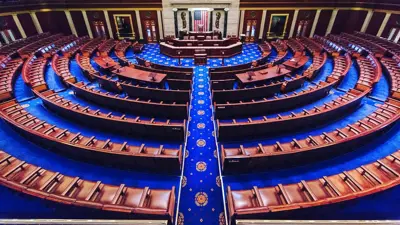Billions on the Line: What NY County Officials Should Know About House Medicaid & SNAP Cuts
The House and Senate are continuing to move through the Budget Reconciliation process with multiple Committees in the House passing their respective portions of the budget package this week. As we have discussed in recent weeks, each chamber and select committees within each chamber have been provided with tax and spending cut targets. Once the individual committees act on their portions of the “one, big, beautiful bill” these individual bills go to the Budget Committee in each chamber to be combined into one bill and set the stage for a floor vote on the whole package.
The House is hoping to pass their version of the package by Memorial Day, with the Senate looking for July 4th for their version. There is significant disagreement in approaches and goals between the two chambers and each budget package will have to be reconciled into one bill that must pass each chamber. Conservatives in both chambers want bigger spending cuts, more immediate implementation of spending cuts, and they want tax cuts to be permanent. Moderates are concerned about cuts in services that are being proposed as too big, and Republicans from high tax/high property value states are still concerned about the SALT cap being too low.
Key Medicaid Takeaways
The House budget bill provides for at least $700 billion in Medicaid cuts, as passed out of committee. The exact impact on New York State is unclear, but in the simplest terms New York represents about 11 percent of the federal spending on Medicaid so we assume the cuts would be distributed somewhat proportionately.
Major initiatives include:
- Postponing Biden era enrollment and eligibility rules for Medicare savings programs, and Medicaid, CHIP, and Basic Health Plans until 2035. Initial federal savings are projected to be $163 billion over 10 years.
- Capping current health care provider taxes in all states and eliminating newly approved ones for New York and a handful of other states within the next year ($2 billion negative impact to New York over the next 3 years). Ten-year savings estimates nationally are $87 billion.
- Implementing expanded work requirements for Medicaid recipients. Effective in 2028 and beyond and estimated to save about $300 billion in total by 2034.
- Cutting enhanced ACA eFMAP to states that use any part of their Medicaid infrastructure to provide health care to undocumented people using their own funds or any other source of revenue (estimated impact of $1.3 billion annual loss in federal funding for New York).
- More frequent eligibility determinations for recipients, more cross state lines eligibility checks for recipients and health care providers, more frequent address verifications for recipients, and limitations on retroactive eligibility. Estimated savings of $65 billion over 10 years.
Congressional estimates on the impact of these provisions currently project that more than 10 million current recipients will lose their Medicaid or CHIP health coverage, another 1.4 million will lose health coverage linked to state-only funded programs, and 9 million people will become uninsured due to changes in ACA marketplace rules. Overall, due to the overlap with Medicare and other federal programs, about 19 million people are estimated to lose their health insurance or become uninsured in the future.
Many of these cost containment actions do not take effect until 2029 and thereafter so the annual impact would likely be quite high for New York, potentially exceeding $10 billion per year if federal estimates are accurate.
Key SNAP Takeaways
The Agriculture Committee passed a bill that reduces federal SNAP costs by nearly $300 billion over 10 years. Most of these cuts would not begin until after 2028.
The federal savings are achieved by limiting benefits to current and future recipients, not updating the market basket of eligible foods under SNAP, increasing the nonfederal share of administrative costs from 50 percent to 75 percent, and shifting a share of SNAP program/benefit costs to states ranging from 5 percent to 25 percent, based on state error rates in the program.
The 25 percent match would kick in if a state’s error rate is above 10 percent. Today, the average error rate for states is about 12 percent with New York’s at just over 14 percent. A 25 percent matching rate would cost New York about $1.8 billion annually. Currently, counties fund 50 percent of the SNAP administrative costs with the State providing no administrative funding (estimates are not yet available on this cost shift).
Key Tax Takeaways
(All estimates come from the Congressional Joint Committee on Taxation)
The House Ways and Means Committee passed a bill this week that would implement a $3.8 trillion net tax cut ($7.7 trillion in tax cuts offset by $3.9 trillion in tax increases). Many of the new tax cuts phaseout after a few years and if they were to be continued by a future Congress and President the net revenue loss for the federal government would likely increase by another $1 trillion over 10 years.
In an odd twist, the bill that passed continues many of the Biden era clean energy incentives and only begins phasing them out after President Trump’s term ends in 2029. After that point, the phaseout would save the federal government about $200 billion over the 10-year budget window. Consumer tax credits of up to $7,500 for electric vehicles would be phased out beginning in 2025.
The tax package is comprised of 118 separate actions with about 60 percent of these actions cutting taxes and 40 percent increasing taxes (the two biggest tax increases are the permanent extension of the elimination of personal exemptions $1.9 trillion, and an extension of a modified SALT cap that would increase from $10k to $30k for married couples but still generate $915 billion in higher taxes, both over 10 years).
New tax cuts proposed by President Trump are included in the bill (all these tax cuts sunset 12/31/2028):
- No tax on tipped income (within set parameters) – $40 billion over 4 years.
- No tax on overtime (within certain thresholds) – $124 billion over 4 years.
- Enhanced deduction for seniors ($4,000) – instead of no tax on social security benefits - $72 billion over 4 years.
- No tax on car loan interest - $58 billion over 4 years.
- Money Accounts for Growth and Advancement (MAGA Accounts). This proposal allows parents to open special tax-preferred savings accounts with annual deposits of up to $5,000 for their children (like 529 education accounts, but with more available uses for expending the funds in the future). For U.S. citizens born between January 1, 2024, and December 31, 2028, the federal government will contribute $1,000 per child into every eligible MAGA account (this provision is expected to cost $13 billion over four years).
As mentioned, because the bill has numerous tax increases, tax cuts that sunset, and family circumstances are different, some segments of the population will experience tax increases. People from high tax “SALT states” will still not benefit as much depending on where the new cap lands and their family situation.
Many tax filers at the lower end of the income schedule will see their federal tax rate increase within a year of two of enactment. By 2033, versus current tax law, 43 million tax filers earning less than $30,000 per year will see their tax rate increase dramatically. Tax filers earning less than $15,000 would see their tax rate increase by nearly 76 percent (many of these people currently have negative tax rates). The biggest proportionate reduction in tax rates (between 7% — 8% on average) would accrue to tax filers with incomes between $50,000 and $1 million.
Contact Us
New York State Association of Counties
515 Broadway, Suite 402
Albany, NY 12207
Phone: (518) 465-1473
Fax: (518) 465-0506

